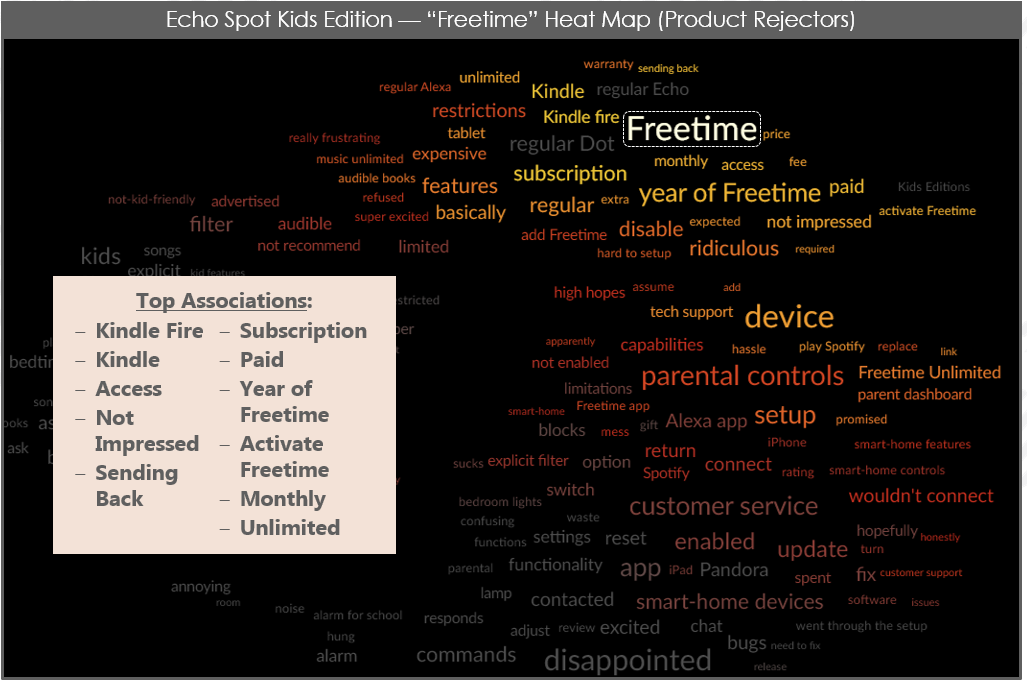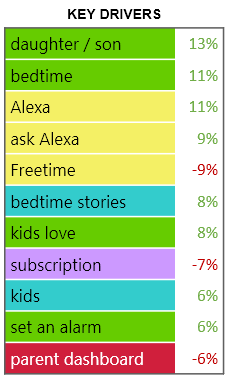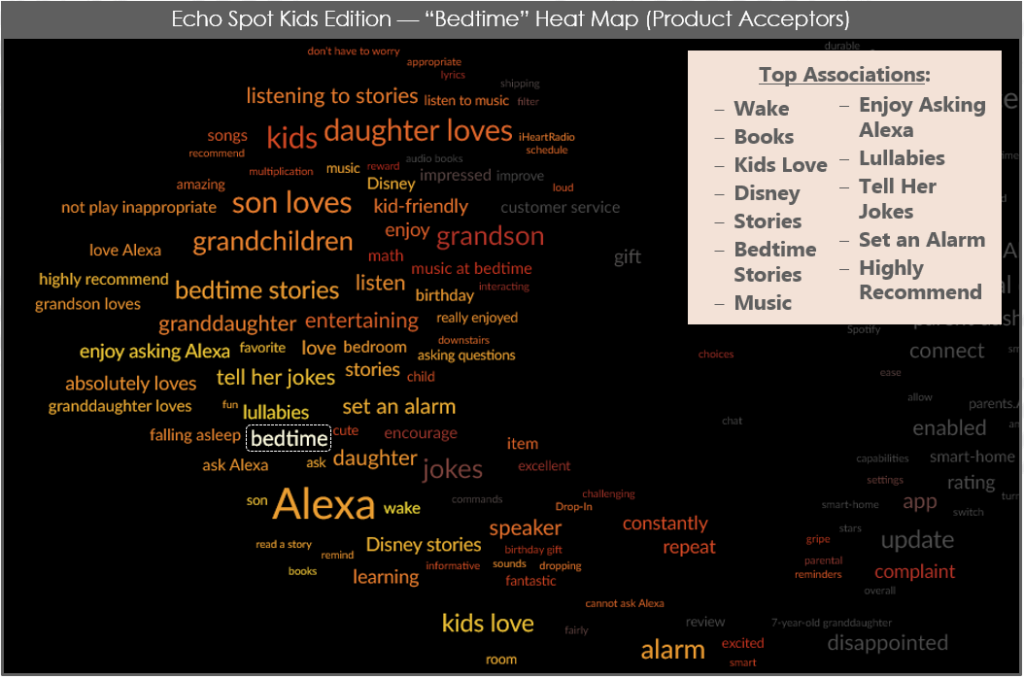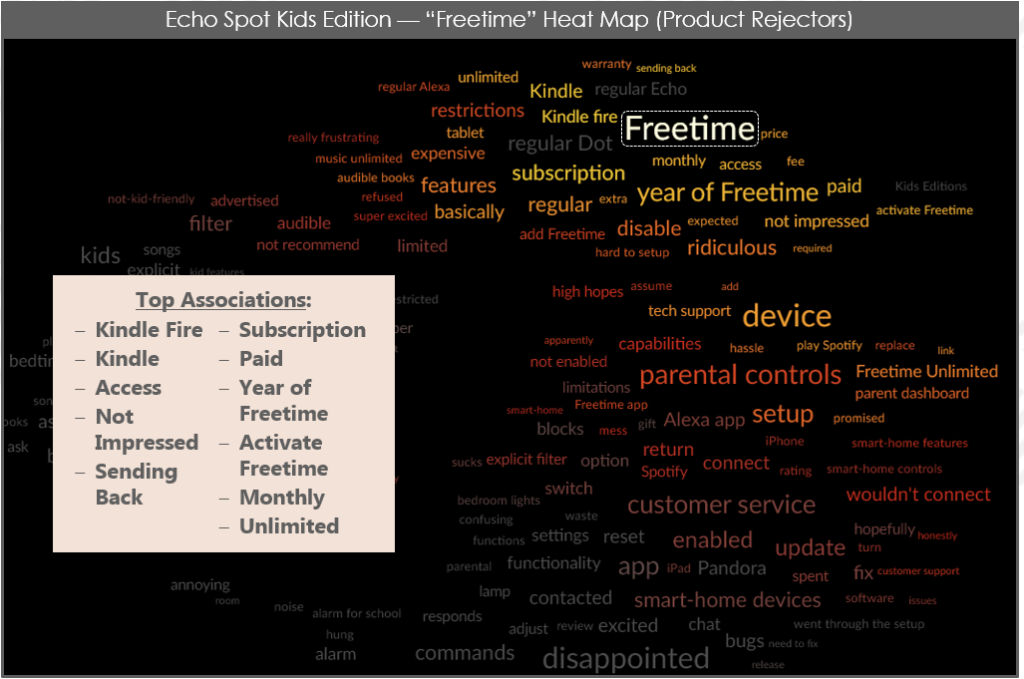As discussed in a recent post, Pathfinder Analytics recently conducted an analysis of online reviews for the Amazon Echo Dot Kids Edition product that combined Pathfinder Text Analytics and Driver Pathways modeling. This analysis identified a number of key drivers of product satisfaction; words or phrases that, when mentioned in a review, had a notable impact on the reviewer’s final rating of the product:
Now that these key drivers have been identified we can gain deeper insights into what they really mean to reviewers by returning to the Text Analytics data and running heat maps to learn which other words these drivers are most associated with — that is, the other words or phrases most commonly used in conjunction with each driver.
For example, a heat map of the term bedtime among product Acceptors (who gave the product 4-5-star ratings) reveals the types of product features and activities they tended to associate with bedtime in their reviews:
The first thing to note is the large number of words and phrases that are lit up in yellow and orange across the map, showing how widely connected bedtime is to a wide variety of different concepts. This lets us know that bedtime is a powerful word on the map with a strong network of positive associations — in keeping with its status as one of the top drivers of product satisfaction — and a strong candidate for use in product messaging.
Now looking specifically at bedtime’s Top Associations listed at the upper right of the map, notice how these associations fall into a handful of themes:
-
- Alexa’s ability to tell stories (books, Disney, bedtime stories)
- Alexa playing songs (lullabies, music)
- Alexa’s interactions with children (enjoy asking Alexa, tell her jokes, kids love)
- Waking up the next morning (wake, set an alarm)
Taken together these four themes provide a simple overview of the Alexa-enhanced bedtime experience. It’s easy to see how, using this list, the Kids Edition brand team could craft product messaging showing the various facets of Alexa’s interactions with children as they get ready for bed, fall asleep to a story or lullaby, and wake up to a personalized alarm — a scenario that would simply and effectively convey to potential buyers why many current owners are pleased with their Echo Spot.
Similarly, we can explore the Kids Edition’s negative drivers by looking at a heat map of the term Freetime (the top negative driver on our list) among Rejectors (who gave the product 1-3-star ratings):
This heat map reveals two primary areas of strong association: the Freetime subscription itself (which is itself a strong negative driver on our Key Drivers list), and issues related to the Kindle and Kindle Fire — relatively small terms on the map overall, but one that are very strongly associated with Freetime in Rejector reviews.
What’s interesting is that issues with the Kindle didn’t emerge on the list of key drivers, nor are they particularly prominent on the overall map. Only by doing a deep dive like this does it become apparent that the Kids Edition has a serious problem with Freetime/Kindle interaction that’s driving down review scores.
For a better look at exactly what’s behind this association, we can pull up some quotes from the reviews and see what Rejectors are having trouble with:
“In activating Freetime, Amazon neglected to inform me that there a known problem with the Kindle refusing to accept the correct password which is required to set-up a pin. So I’m completely locked out of my device. If I cancel Freetime, I can get back into my Kindle, but they will not honor the one free year if I do that.”
— 1 Star Review
“The Kindle unlimited features are as convoluted as everything else about this device. You have to search for a list of available features, manually add them to the device, then go back through and authorize your kids to use them. This cannot be done from the device or the app.”
— 1 Star Review
Now the team at Amazon can zero in on one of the key issues they need to address to help bring up the product’s overall review rating.
Naturally this is just the tip of the iceberg, but it should give an idea of how these techniques can be combined to identify the product features that are helping to drive online product ratings — using nothing more than the text data of the reviews themselves.
In summary, the process to identify and define the drivers of online reviews is this simple:
-
- Run Pathfinder Text Analytics on the review text data to produce a simple visual map that shows how reviewers are using words and phrases in their reviews.
- Run Pathfinder Driver Pathways on the text analytics data to identify the key drivers of product ratings.
- Deep dive into the Pathfinder Text Analytics results via heat maps to learn what those key drivers mean to reviewers.
For more information about Pathfinder Text Analytics or this research in particular, please contact us to set up some time for us to take you through our findings and find ways we might help you learn more about your customers and how they perceive and interact with your brand and your products.













